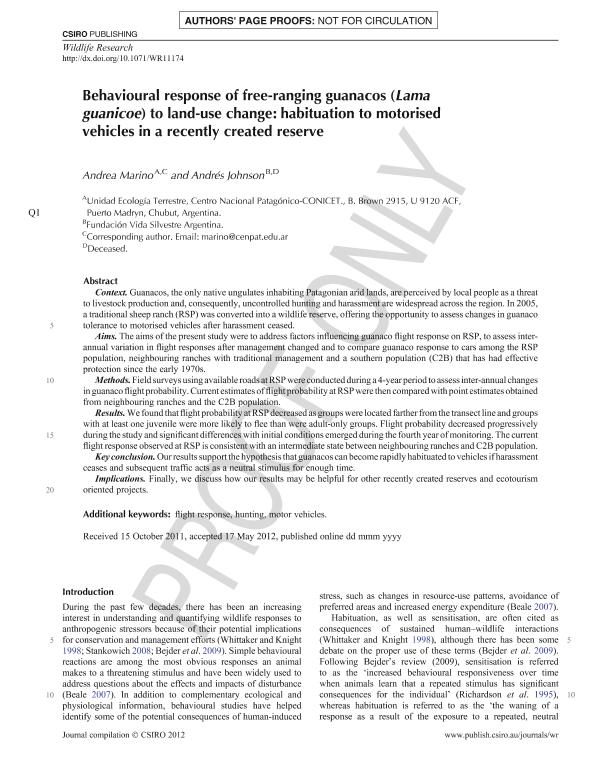Mostrar el registro sencillo del ítem
dc.contributor.author
Marino, Andrea Ivana

dc.contributor.author
Johnson, Andrés
dc.date.available
2019-01-29T19:24:11Z
dc.date.issued
2012-05
dc.identifier.citation
Marino, Andrea Ivana; Johnson, Andrés; Behavioural response of free-ranging guanacos (Lama guanicoe) to land-use change: Habituation to motorised vehicles in a recently created reserve; Csiro Publishing; Wildlife Research; 39; 6; 5-2012; 503-511
dc.identifier.issn
1035-3712
dc.identifier.uri
http://hdl.handle.net/11336/68878
dc.description.abstract
Context Guanacos, the only native ungulates inhabiting Patagonian arid lands, are perceived by local people as a threat to livestock production and, consequently, uncontrolled hunting and harassment are widespread across the region. In 2005, a traditional sheep ranch (RSP) was converted into a wildlife reserve, offering the opportunity to assess changes in guanaco tolerance to motorised vehicles after harassment ceased. Aims The aims of the present study were to address factors influencing guanaco flight response on RSP, to assess inter-annual variation in flight responses after management changed and to compare guanaco response to cars among the RSP population, neighbouring ranches with traditional management and a southern population (C2B) that has had effective protection since the early 1970s. Methods Field surveys using available roads at RSP were conducted during a 4-year period to assess inter-annual changes in guanaco flight probability. Current estimates of flight probability at RSP were then compared with point estimates obtained from neighbouring ranches and the C2B population. Results We found that flight probability at RSP decreased as groups were located farther from the transect line and groups with at least one juvenile were more likely to flee than were adult-only groups. Flight probability decreased progressively during the study and significant differences with initial conditions emerged during the fourth year of monitoring. The current flight response observed at RSP is consistent with an intermediate state between neighbouring ranches and C2B population. Key conclusion Our results support the hypothesis that guanacos can become rapidly habituated to vehicles if harassment ceases and subsequent traffic acts as a neutral stimulus for enough time. Implications Finally, we discuss how our results may be helpful for other recently created reserves and ecotourism oriented projects. © 2012 CSIRO.
dc.format
application/pdf
dc.language.iso
eng
dc.publisher
Csiro Publishing

dc.rights
info:eu-repo/semantics/openAccess
dc.rights.uri
https://creativecommons.org/licenses/by-nc-sa/2.5/ar/
dc.subject
Flight Response
dc.subject
Hunting
dc.subject
Motor Vehicles
dc.subject.classification
Otras Ciencias Biológicas

dc.subject.classification
Ciencias Biológicas

dc.subject.classification
CIENCIAS NATURALES Y EXACTAS

dc.title
Behavioural response of free-ranging guanacos (Lama guanicoe) to land-use change: Habituation to motorised vehicles in a recently created reserve
dc.type
info:eu-repo/semantics/article
dc.type
info:ar-repo/semantics/artículo
dc.type
info:eu-repo/semantics/publishedVersion
dc.date.updated
2018-12-05T14:34:43Z
dc.journal.volume
39
dc.journal.number
6
dc.journal.pagination
503-511
dc.journal.pais
Australia

dc.journal.ciudad
Collingwood
dc.description.fil
Fil: Marino, Andrea Ivana. Consejo Nacional de Investigaciones Científicas y Técnicas. Centro Científico Tecnológico Conicet - Centro Nacional Patagónico. Instituto Patagónico para el Estudio de los Ecosistemas Continentales; Argentina
dc.description.fil
Fil: Johnson, Andrés. Fundación Vida Silvestre; Argentina
dc.journal.title
Wildlife Research

dc.relation.alternativeid
info:eu-repo/semantics/altIdentifier/url/https://bioone.org/journals/wildlife-research/volume-39/issue-6/WR11174/Behavioural-response-of-free-ranging-guanacos-iLama-guanicoe-i-to/10.1071/WR11174.short
dc.relation.alternativeid
info:eu-repo/semantics/altIdentifier/doi/http://dx.doi.org/10.1071/WR11174
Archivos asociados
